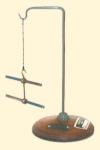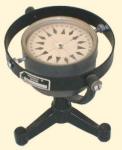 Menu
Menu
|
Function Model of the astatic system of Nobili’s Galvanometer with its needle independent from the terrestrial magnetic field. |

| ||
|
|||
|
Description It is formed by two opposed magnetic needles suspended from a support by a silk thread. The two needles are painted and the opposition of the polar ends is quite evident. | |||
|
Function Orientation. |

| ||
|
|||
|
Description The support column of the graduated circle turns on a tripod with three foot screws, and it has an index that slides on the disk fixed on the tripod. The fork holds the upper graduated circle, that can turn along its diameter. The rotation can be read on a third graduated disk, fixed perpendicularly to the plane of the upper circle. A plumb line at a side of the column is used to put the column in vertical position. | |||
|
Function Orientation. |

| ||
|
|||
|
Description The heavy box (compass bowl) is held by a brass ring, on which it turns along a certain diameter. The ring then turns on the vertical fork along a second diameter perpendicularly to the first. As the centre of gravity is very low, the compass always rests on a horizontal plane and its centre of gravity comes vertically under the cross point of the two diameters along which the compass and the ring turn. The support of the magnetic needle is along the axis of the compass. The needle is fixed to the rose and therefore it is not visible. | |||